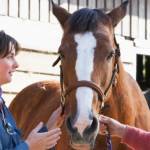Proud Flesh in Horses: An Overview

Following a soft tissue injury to the limbs, many horses seem to embrace the notion that anything worth doing is worth overdoing. In this case, the “overdoing” component refers to the production of excessive scar tissue called exuberant granulation tissue (EGT) or proud flesh—an unsightly overgrowth of tissue in a healing wound that poses significant treatment challenges, delays healing and return to work and, in some cases, results in the loss of the horse.
Despite best efforts by veterinarians, an ideal treatment strategy for EGT remains elusive. Past efforts included prolonged bandaging, trimming excessive tissue, applying various creams and salves, and even grafting tissue to expedite healing with normal, healthy skin. Other veterinarians, however, suggest that bandaging promotes EGT formation and that bacterial contamination of the wound also contributes to the problem.
To help find a solution to this problem, a group of researchers* compared the impact of three different topical products on EGT formation. In their study, wounds in the distal limb of eight horses were used. Those wounds were then contaminated with bacteria and fungi and bandaged. Horses then received one of four treatments: application of topical 1% silver sulfadiazine cream (SSC), triple antimicrobial ointment (TAO), hyperosmolar nanoemulsion (HNE), or no treatment. HNE is a novel compound that purportedly disrupts cell membranes (of bacteria, for example) and contains sugars that act like honey or sugar treatments to exert an antibacterial effect.
Key findings of the study included:
- Time to wound closure for all horses regardless of treatment was 42 days;
- Microbial counts (an indicator of wound contamination with bacteria) were significantly higher for HNE-treated wounds on days 9 and 21, compared with SSC-treated and TAO-treated wounds, but not controls; and
- Trimming of EGT was required more frequently in SSC- or HNE-treated wounds than the TAO-treated wounds and even the control group receiving no treatment.
In sum, the authors concluded, “None of the treatments resulted in more rapid wound closure, compared with that for untreated control wounds under the study conditions.”
“One key to healthy skin and coat involves proper nutrition and an adequate supply of key nutrients such as biotin, zinc, lysine, methionine, iodine, lecithin, and omega-3 fatty acids. These ingredients can be found in Bio-Bloom PS (Bio-Bloom HF in Australia) and EO•3,” advised Kathleen Crandell, Ph.D., a nutritionist for Kentucky Equine Research (KER).
*Harmon, C.C.G., J.F. Hawkins, J. Li, et al. 2017. Effects of topical application of silver sulfadiazine cream, triple antimicrobial ointment, or hyperosmolar nanoemulsion on wound healing, bacterial load, and exuberant granulation tissue formation in bandaged full-thickness equine skin wounds. American Journal of Veterinary Research. 78(5):638-646.








